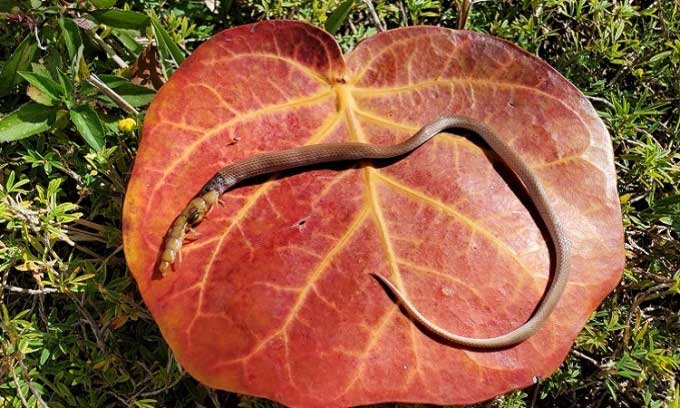Researchers Discover Rim Rock Crowned Snake Dead While Attempting to Swallow a Giant Centipede.
The Rim Rock Crowned Snake (Tantilla oolitica) has been recently discovered in a park in the Florida Keys after being absent for four years. The snake died while attempting to swallow a massive centipede that was one-third its size. This fatal encounter marks the first time scientists have observed the feeding habits of the T. oolitica. Close relatives of T. oolitica also consume centipedes, but this snake is so rare that no one previously knew what it ate. A research team at the Florida Museum of Natural History took CT scans of the snake along with its prey and will publish their findings on September 11 in the journal Ecology.

T. oolitica snake attempting to consume oversized prey. (Photo: Drew Martin).
“I was astonished to see the photos for the first time,” said Coleman Sheehy, co-author of the study and curator of reptiles at the Florida Museum. “Finding a specimen that died while eating is extremely rare, especially considering the rarity of T. oolitica. I never expected to discover such a specimen. We were all shocked.”
A hiker spotted the snake along a trail at John Pennekamp Coral Reef State Park in Key Largo and reported it to the management. The specimen was quickly transferred to the Florida Museum for an investigation into the exact cause of its death.
The most obvious explanation is that the T. oolitica suffocated due to the giant centipede that was one-third its size. However, snakes often consume prey significantly larger than themselves. Unlike human teeth and those of most vertebrates, snake jaws are equipped with flexible ligaments and muscles, allowing them to constrict around their prey.
To confirm their hypothesis, the research team needed to examine the inside of the snake’s body. In the past, this would have required dissecting the specimen, potentially causing damage that could hinder future research. However, scientists applied CT scanning technology, which allows for anatomical examination of a specimen without physical alteration. Jaimi Gray, a research assistant at the museum, stained the snake with iodine solution to enhance the contrast of the intestinal tissue and constructed a 3D model from the images.
The model revealed a small wound on the side of the snake, likely caused by the powerful venomous fangs of the centipede. Snakes that eat centipedes typically have some form of venom resistance, but this assumption has not been proven. The bite appeared to cause internal bleeding, but the toxin was not strong enough to prevent the snake from killing and swallowing the centipede.
Instead, the fatal blow seems to have been the size of the centipede. Detailed examination of the CT images showed that the snake’s trachea was constricted precisely at the perimeter of the largest centipede, blocking its airway.
The T. oolitica once thrived in the pine forests stretching from central Florida to the Keys, but its numbers have since plummeted. This snake has been listed as threatened in Florida since 1975.


















































